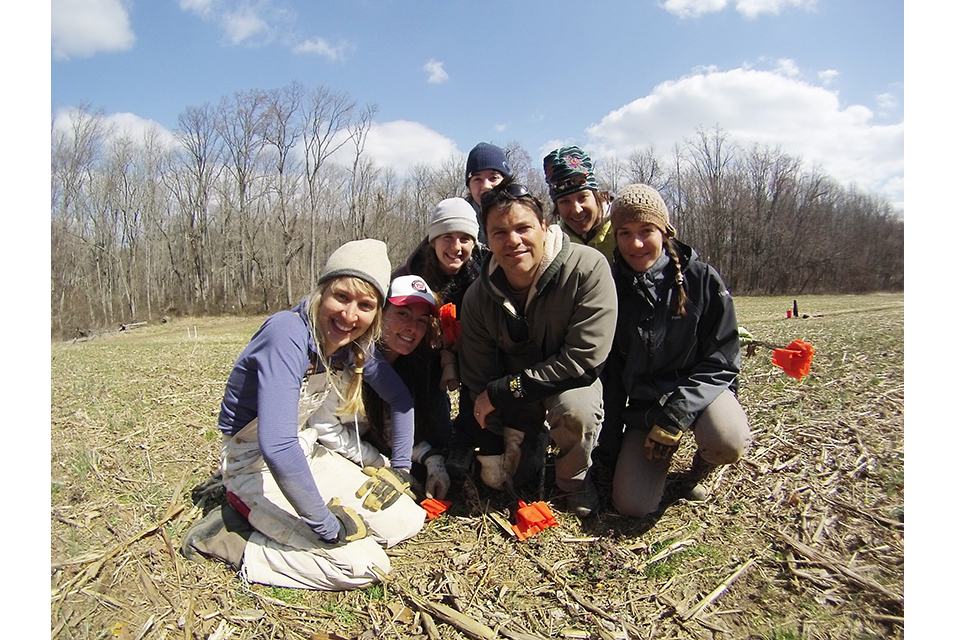EDGEWATER, MD.- Planting forests with diverse species can help ensure their success, according to a new study published May 18 from the
Smithsonian Environmental Research Center and The Nature Conservancy. The discovery is the result of a decade of research from BiodiversiTREE, a large-scale reforestation project at SERC designed to run 100 years, testing the effects of different tree planting strategies on sapling survival and other ecosystem functions.
Forests are naturally diverse, and this diversity of plant species brings an array of benefits: pest and disease resistance, resilience to climate change and increased wildlife habitat. However, nearly all forest plantations, and some restoration projects, are planted as monocultures—where a single plant species is grown on the land. This practice leaves both managed and unmanaged forests ecologically and economically vulnerable to changing conditions. Another disadvantage of monocultures is the risk of planting failure—where a sapling fails to thrive—and early mortality.
Hundreds of scientific studies have shown that biodiversity enhances ecosystem function, suggesting that diversity in tree plantings could improve their survival outcomes. Yet there have been few tests of this hypothesis on trees. Scientists designed BiodiversiTREE to test whether tree diversity impacts ecosystem function—the largest experiment of its kind in North America.
In 2013, scientists and 100 volunteers created BiodiversiTREE by planting 20,000 saplings on former agricultural land near Chesapeake Bay. In some sections the scientists and volunteers planted a single species, and in others four or 12 species. Around 8,000 trees planted in the project were monitored yearly for the first three years, and then every two to three years thereafter.
Ten years in, the results showed that reforestation projects with diverse species are more likely to include species that thrive at the planting site, lowering the risk of planting failure.
“Even planting four species instead of just one significantly reduced variation in survival in our plots, showing that small increases in diversity could have large impacts on the success of tree planting efforts,” said Rachel King, forest ecologist at SERC and lead author of the study, published in the journal Restoration Ecology.
The results echo previous tree diversity experiments showing that monocultures can both thrive and utterly fail, making it risky to plant only one species. Single-species plots in BiodiversiTREE were prone to “boom or bust,” with species like sycamore seeing 99% survival rates while hickory plots struggled around 21%. However, diverse plots were much more stable. Overall, the variability of survival in single-species plots was roughly double the variability in 4- and 12-species plots.
Forest ecosystems cover almost a third of the land on Earth, supporting most of its terrestrial species and the livelihoods of millions of people around the world. Forests are also critical in the fight against climate change. In the United States alone, there are up to 148 million acres of opportunity to restore forest cover, which could capture 535 million tons of carbon dioxide per year, or the equivalent of removing 116 million cars from the road.
“Tree planting alone will not solve climate change, but done right, has significant potential as a natural climate solution,” said Susan Cook-Patton, senior forest restoration scientist at The Nature Conservancy and co-author of the paper. “If we are going to invest in tree planting, it is important to make sure those new forests are set up for success by employing a diverse set of native species.”
The Chesapeake Bay is the largest estuary in the United States and the third largest in the world, spanning six states and Washington, D.C. But human activities such as overfertilization have imperiled what was once one of the most productive estuaries in the world. Planting trees in this critical watershed will thus help to rehabilitate both the land and waters.
“Forests play important roles by filtering out nutrients, and reforesting a whole watershed—like we did with BiodiversiTREE—can provide valuable insights into improving the health of the Chesapeake Bay,” said Jamie Pullen, co-author and head technician in the Terrestrial Ecology Lab at SERC.
“Reforestation and tree plantings are an increasing part of natural climate solutions, but few projects monitor their survival outcomes or their impacts on other ecosystem functions,” said John Parker, senior scientist at SERC and director of BiodiversiTREE. “BiodiversiTREE and a network of similar projects in the TreeDivNet global consortium seek to fill these knowledge gaps and provide sound science for better ecosystem management.”










